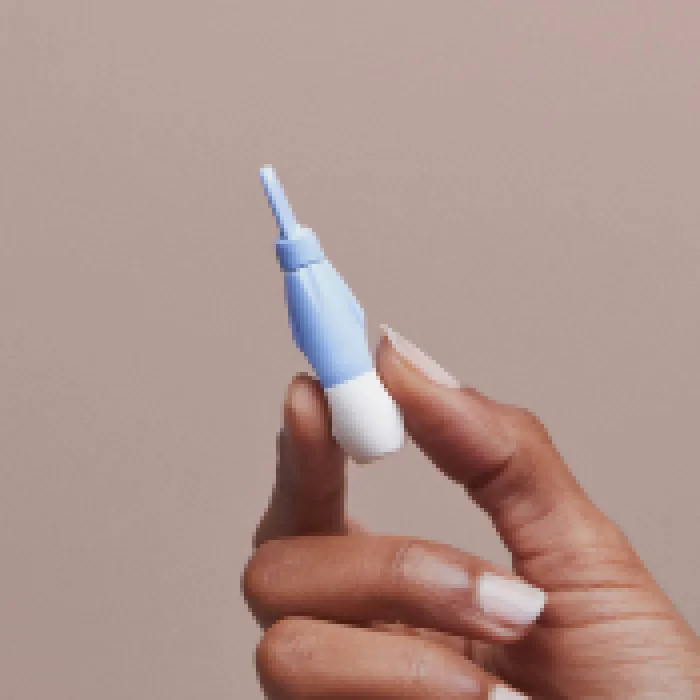Here's what we'll cover
Here's what we'll cover
If you or your partner smoke weed and are trying to get pregnant, you may wonder if it’s affecting your ability to conceive.
To err on the safe side, you may want to put a pause on your marijuana consumption. So, how long after quitting smoking weed does fertility improve? It takes more than two months to produce sperm, so you can estimate around the same time for fertility to be at its best.
Can you become infertile from smoking weed?
The research is not conclusive, but some studies suggest that smoking weed may affect fertility––especially in men. These studies have linked marijuana use with factors that can influence male fertility, including (Payne, 2019; Pacey, 2014):
Reduced sperm motility (how well sperm moves)
Reduced sperm count and concentration
Poor sperm morphology
Reduced sexual performance or desire
Other side effects of chronic marijuana use for men may include erectile dysfunction (ED), low libido (sex drive), and potential changes in reproductive hormones (Payne, 2019; Gundersen, 2015). In women, chronic cannabis use may affect monthly menstrual cycles (Ilnitsky, 2019).
Does weed affect sperm?
Some researchers have found that smoking weed may cause disruptions in sperm production and function.
One study of more than 1,200 healthy, young men found that smoking marijuana two or more times per week resulted in a 28% lower sperm concentration and 29% reduced sperm count. Combining marijuana with other recreational drugs reduced sperm concentration by 52% and count by 55% (Gundersen, 2015).
Chronic cannabis use may also impact sperm morphology or the structure of sperm, according to some studies. This can negatively affect fertility as abnormally shaped sperm can’t swim as well, which affects their ability to reach the egg.
Despite these potentially negative effects on sperm quality, however, other studies have found that smoking weed does not significantly impact the time it takes to get pregnant (Wise, 2018; Kasman, 2018).
Does smoking weed cause erectile dysfunction?
Many factors cause ED, and regularly smoking marijuana could be one. Cannabis interacts with receptors in the body’s endocannabinoid system, which are also located in the part of the brain that regulates sexual behavior and erectile function.
That doesn’t mean if you smoke once you’ll experience erection problems. Marijuana use may have a dose-dependent effect on erections; this essentially means that when smoking higher doses of marijuana, the higher your risk is of ED. However, lesser doses may actually heighten sexual desire and sensations during intercourse (Rajanahally, 2019).
Overall, information about how marijuana can affect your sex life is conflicting. Some studies show people report increased pleasure, stronger orgasms, and are able to last longer in bed when using marijuana, with no connection identified between ED and smoking weed.
Other studies have found that daily marijuana users have almost double the rate of ED, and that smoking cannabis may lead to premature ejaculation (Rajanahally, 2019).
Marijuana and female fertility
Given its interaction with the body’s endocannabinoid system, smoking weed could cause hormonal changes that affect ovulation (Brents, 2016).
Small studies have found that smoking weed may also be associated with an increase in anovulatory cycles (menstrual cycles where an egg is not released). In a large study of women with a history of pregnancy loss, cannabis users were 40% less likely to conceive each menstrual cycle (Mumford, 2021).
At the same time, other research indicates that smoking marijuana does not have any significant impact on fertility for men or women (Wise, 2018). Some survey data suggest that as long as you smoke once per day or less, it won’t affect the length of time it takes to get pregnant (Ilnitsky, 2019).
Because information is conflicting, it’s tough to say with any certainty what the impact is of marijuana on female fertility.
How long after quitting smoking weed does fertility improve?
It takes more than two months to produce sperm. If cannabis use is affecting your fertility, it might take at least that long to improve sperm quality (O’Donnell, 2017).
Marijuana lingers in the body longer for chronic users. If you smoke every once in a while, your system might be able to flush out weed within a few days. For regular users, marijuana can take a couple of weeks or more to leave the body (Sharma, 2012).
How cigarette smoking affects fertility
When it comes to cigarette smoking and fertility, the science is clear: smoking is linked to higher rates of infertility. Once pregnant, smoking is a risk factor for serious complications during pregnancy and for fetal health (Kovac, 2015; ASRM, 2018).
Women who smoke cigarettes have higher rates of infertility and take longer to conceive. They also may experience menopause earlier (by roughly 1–4 years) earlier than those who do not smoke. Women who smoke also have an increased risk of an ectopic pregnancy, which is when a fertilized egg grows outside the uterus.
Men who smoke cigarettes may also have lower sperm counts and produce less semen than those who don’t. They also have been found to have lower-quality sperm with less motility. Research shows that the more cigarettes you smoke, the lower your sperm concentration might be (Kovac, 2015).
The bottom line on smoking weed and fertility
More large-scale studies are needed before any conclusions can be drawn. Many studies have found an association between the use of cannabis and factors that can result in infertility.
At the same time, other studies have found that marijuana doesn’t have a measurable impact on the time it takes to get pregnant. If you think you may have a fertility problem, talk to a healthcare provider. They can recommend lifestyle changes and other treatment options that may help.
DISCLAIMER
If you have any medical questions or concerns, please talk to your healthcare provider. The articles on Health Guide are underpinned by peer-reviewed research and information drawn from medical societies and governmental agencies. However, they are not a substitute for professional medical advice, diagnosis, or treatment.
Brents, L. K. (2016). Marijuana, the Endocannabinoid System and the Female Reproductive System. The Yale Journal of Biology and Medicine , 89 (2), 175–191. Retrieved from https://pubmed.ncbi.nlm.nih.gov/27354844/
Gundersen, T. D., Jørgensen, N., Andersson, A. M., et al. (2015). Association Between Use of Marijuana and Male Reproductive Hormones and Semen Quality: A Study Among 1,215 Healthy Young Men. American Journal of Epidemiology , 182 (6), 473–481. doi:10.1093/aje/kwv135. Retrieved from https://pubmed.ncbi.nlm.nih.gov/26283092/
Ilnitsky, S. & Van Uum, S. (2019). Marijuana and fertility. Canadian Medical Association Journal , 191 (23), E638. doi:10.1503/cmaj.181577. Retrieved from https://pubmed.ncbi.nlm.nih.gov/31182459/
Kasman, A. M., Thoma, M. E., McLain, A. C., & Eisenberg, M. L. (2018). Association between use of marijuana and time to pregnancy in men and women: findings from the National Survey of Family Growth. Fertility and Sterility, 109 (5), 866–871. doi:10.1016/j.fertnstert.2018.01.015. Retrieved from https://pubmed.ncbi.nlm.nih.gov/29555335/
Kovac, J. R., Khanna, A., & Lipshultz, L. I. (2015). The effects of cigarette smoking on male fertility. Postgraduate Medicine , 127 (3), 338–341. doi:10.1080/00325481.2015.1015928. Retrieved from https://pubmed.ncbi.nlm.nih.gov/25697426/
Mumford, S. L., Flannagan, K. S., Radoc, J. G., et al. (2021). Cannabis use while trying to conceive: a prospective cohort study evaluating associations with fecundability, live birth and pregnancy loss. Human Reproduction (Oxford, England) , 36 (5), 1405–1415. doi:10.1093/humrep/deaa355. Retrieved from https://pubmed.ncbi.nlm.nih.gov/33421071/
O'Donnell, L., Stanton, P., & de Kretser, D. M. (2017). Endocrinology of the Male Reproductive System and Spermatogenesis. Endotext . Retrieved from https://pubmed.ncbi.nlm.nih.gov/25905260/
Pacey, A. A., Povey, A. C., Clyma, J. A., et al. (2014). Modifiable and non-modifiable risk factors for poor sperm morphology. Human Reproduction (Oxford, England) , 29 (8), 1629–1636. doi:10.1093/humrep/deu116. Retrieved from https://pubmed.ncbi.nlm.nih.gov/24899128/
Payne, K. S., Mazur, D. J., Hotaling, J. M., & Pastuszak, A. W. (2019). Cannabis and Male Fertility: A Systematic Review. The Journal of Urology , 202 (4), 674–681. doi:10.1097/JU.0000000000000248. Retrieved from https://pubmed.ncbi.nlm.nih.gov/30916627/
Practice Committee of the American Society for Reproductive Medicine. (2018). Smoking and infertility: a committee opinion. Fertility and Sterility , 110 (4), 611–618. doi:10.1016/j.fertnstert.2018.06.016. Retrieved from https://pubmed.ncbi.nlm.nih.gov/30196946/
Rajanahally, S., Raheem, O., Rogers, M., et al. (2019). The relationship between cannabis and male infertility, sexual health, and neoplasm: a systematic review. Andrology , 7 (2), 139–147. doi:10.1111/andr.12585. Retrieved from https://pubmed.ncbi.nlm.nih.gov/30767424/
Sharma, P., Murthy, P., & Bharath, M. M. (2012). Chemistry, metabolism, and toxicology of cannabis: clinical implications. Iranian Journal of Psychiatry , 7 (4), 149–156. Retrieved from https://pubmed.ncbi.nlm.nih.gov/23408483/
Verze, P., Margreiter, M., Esposito, K., et al. (2015). The Link Between Cigarette Smoking and Erectile Dysfunction: A Systematic Review. European Urology Focus , 1 (1), 39–46. doi:10.1016/j.euf.2015.01.003. Retrieved from https://pubmed.ncbi.nlm.nih.gov/28723353/
Wise, L. A., Wesselink, A. K., Hatch, E. E., et al. (2018). Marijuana use and fecundability in a North American preconception cohort study. Journal of Epidemiology and Community Health, 72 (3), 208–215. doi:10.1136/jech-2017-209755. Retrieved from https://pubmed.ncbi.nlm.nih.gov/29273628/












